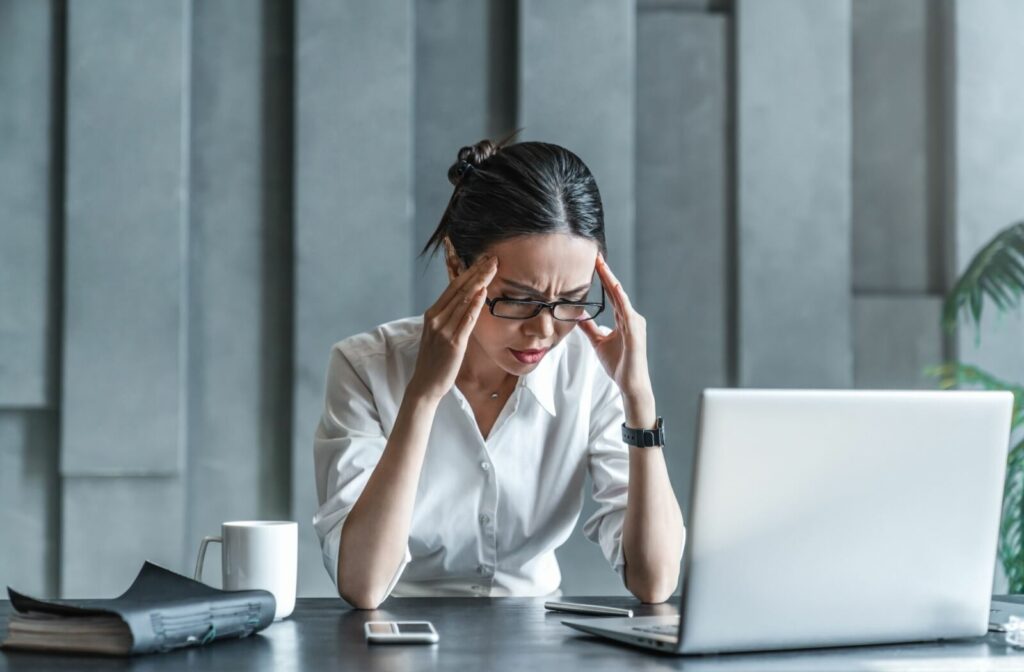It’s not uncommon to experience dry, irritated eyes and a headache simultaneously. While dry eyes don’t directly cause headaches, they can aggravate headache symptoms, even though they may seem unrelated. Understanding the connection between these 2 issues can help you find relief and take better care of your eyes and overall well-being.
Simple solutions like lubricating eye drops are sometimes enough to alleviate dry eyes and prevent related headaches. For persistent dry eye symptoms, however, it’s important to discuss your treatment options with your eye doctor, as ongoing and chronic conditions require dry eye therapy.
What Is Dry Eye?
Dry eye is a common condition that occurs when your eyes don’t produce enough tears or when the tears evaporate too quickly.
While tears might not seem particularly exciting, they’re essential for maintaining your eyes’ overall health and comfort. Tears provide necessary lubrication, wash away debris, and even protect the eyes from infection. Dry eye symptoms can set in when this natural tear production is disrupted.
What Causes Dry Eye?
Several factors can lead to dry eyes. You may be dealing with 1 or a combination of these causes:
- Aging: Tear production often decreases as you grow older, making dry eye more common in older adults
- Environmental factors: Windy climates, dry air, and smoke can strip moisture from your eyes
- Screen time: Staring at digital screens for prolonged periods can reduce how often you blink, leading to decreased eye lubrication
- Medical conditions: Certain conditions, such as Sjögren’s syndrome or rheumatoid arthritis, can impair tear production
- Medications: Some antihistamines, decongestants, and medications for anxiety or depression can reduce your tear output
- Contact lenses: Wearing contact lenses for extended periods can contribute to dryness by reducing oxygen flow to the eyes and disrupting tear stability
Common Symptoms of Dry Eye
Wondering if you might have dry eye? Here are some telltale signs:
- A stinging, burning sensation in the eyes
- Redness or irritation
- Sensitivity to light
- Blurred vision, especially during tasks like reading or using screens
- Feeling like there’s sand or grit in your eyes
- Excessive tearing (watery eyes)

How Are Dry Eyes and Headaches Connected?
The connection between dry eyes and headaches lies in the strain and tension your eyes experience when they aren’t properly lubricated. When your eyes are strained, they communicate distress signals to other parts of your body, which can exacerbate headache pain.
Eye Strain & Muscle Fatigue
When your eyes are dry, your visual system works harder than usual to focus and see clearly. This extra effort can cause strain on the tiny muscles around your eyes, leading to fatigue. Over time, the tension builds up from poor posture and muscle tension, and it may translate into a headache, particularly around the temples or forehead.
Tension Headaches
Tension headaches are one of the most common headaches. The discomfort, often described as a dull, squeezing pain, can worsen when the stress of dryness triggers tension in the muscles of the face, scalp, and neck.
Migraines
The corneal irritation and sensory nerve activation due to inflammation from dryness can release pain-inducing substances known as neuropeptides. This response might set off a chain reaction, leading to migraine symptoms such as throbbing pain, nausea, and sensitivity to light or sound.
Nerve Stimulation
The cornea, the transparent outer layer at the front of your eye, is rich with nerve endings. When dry eyes irritate the cornea, these nerve endings send amplified pain signals to your brain, which can result in headaches.
Essentially, your eyes’ discomfort doesn’t exist in isolation. The pain pathway from your eyes to your brain can intensify headaches.
Preventing & Managing Dry Eye Symptoms
Managing dry eye symptoms can reduce risk of them increasing headache pain. Here are some effective strategies for keeping your eyes hydrated and relaxed.
Keep Your Eyes Hydrated
Start simple by focusing on hydration. Drink plenty of water throughout the day and use lubricating eye drops (also known as artificial tears) to replenish moisture and soothe your eyes.
Make Environmental Adjustments
Become aware of your surroundings and make minor tweaks to reduce eye discomfort:
- Use a humidifier to add moisture to the air, especially in dry or air-conditioned spaces
- Avoid having fans directed at your face
- Wear sunglasses outdoors to shield your eyes from the wind and harsh sunlight
Give Your Eyes a Rest from Screens
If you spend hours staring at a screen, adopt the 20-20-20 rule as a healthy habit. Every 20 minutes, take a 20-second break to look at something at least 20 feet away. This simple practice can help prevent eye strain and dryness.
Eat a Healthy Diet
Specific nutrients, like omega-3 fatty acids, can promote healthy tear production. Add salmon, walnuts, flaxseeds, and chia seeds to your meals. Consider supplements if needed, but consult a healthcare provider first.
Seek Professional Care
Consult Sea View Optometric if your dry eye symptoms persist despite trying these remedies. They can evaluate the underlying causes of your dry eyes and recommend treatments, such as prescription eye drops, specialized contact lenses, or therapies to promote healthy tear production.
Comprehensive Dry Eye Care in Long Beach
When managing dry eye symptoms feels overwhelming, remember that help is just around the corner. We specialize in diagnosing and treating dry eye conditions at Sea View Optometric. Our team combines personalized care with advanced technologies including OptiLight IPL therapy to relieve symptoms and restore long-lasting comfort.
Do you feel like your dry eyes are causing headaches? Don’t ignore the signs. Book an appointment with us today and take the first step toward better eye and overall health.



